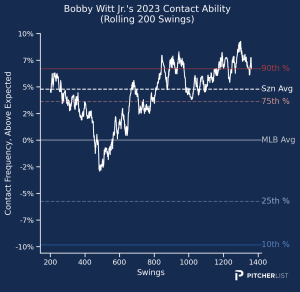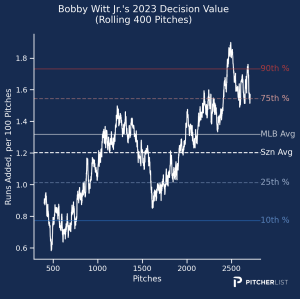In 12-team leagues, there are still more than enough shortstops to go around with as many as nine or ten being drafted in the first four to five rounds. You’ll find quite a bit of speed at the position to go along with plenty of power as the youth movement in baseball is largely propelled by young shortstops across the league.
Of all the positions, I think you can handle shortstop by just seeing who falls to you in the first five rounds or so, and if none come up at an optimal time, you can just wait a while and take a solid option closer to round nine or 10. The depth makes it incredibly easy to adapt your draft strategy on the fly based on your other positional needs as well as category strengths and weaknesses, so while it’s smart to know guys across the player pool, you shouldn’t give yourself too much heartburn making sure you find a serviceable option in most standard leagues.
As with all of the position ranking articles, these blurbs and ranks come from my Top 300 Hitters for Fantasy Baseball 2024 piece that also debuted today! Check that piece out for more on my rankings philosophy and, well, all the rest of my rankings.
Check out the Hacks & Jacks podcast featuring Scott Chu and Joe Gallina, which also happened to be a finalist for Best Baseball Podcast of 2021 by the Fantasy Sports Writers Association (FSWA)!
I also host an AMA in the r/fantasybaseball subreddit every Friday (starting sometime in late March) starting around noon ET that lasts through the rest of the day and into the weekend, so feel free to join the fun and ask questions or make comments.
Tier 1
2. Mookie Betts (2B/SS/OF, LAD) – News that Betts will be the everyday second baseman for the Dodgers is fun because it means he’ll retain his most valuable position in all formats for at least another two seasons. The new stolen base rules didn’t help Betts get back to his pre-2020 speed totals, but a career-high 39 home runs and 233 combined runs and RBI with a .307 batting average makes the lower stolen base totals a non-issue. Betts is locked into the top of the order for the Dodgers, and his fantastic plate discipline ensures the ratios and counting stats will continue to pour in. Those in formats where you need 20 starts to gain positional eligibility won’t be able to plug Betts in as a shortstop, but that doesn’t impact his value in any way. Betts is the clear top dog at second base and also near the top in the outfield, and that’s what matters most.
Tier 2
3. Corey Seager (SS, TEX) – A return to a batting average north of .300 and once again clearing the 30 home run mark was no surprise, but the fact that Seager did it in just 119 games was quite eye-opening. Injuries have always been a factor with Seager as he’s played in just 66% of his team’s games since the start of the 2018 season (which is roughly 107 games in a 162-game season). In a 140-game season, I’d look for Seager to hit 35-40 home runs with high ratios and 200 or more combined runs and RBI. In fact, on a per-game basis, Seager was the fourth-best fantasy hitter among players with at least 250 plate appearances behind Acuna, Ohtani, and Carroll. Assuming you can work around the potential missed time and the lack of steals, there’s a lot to like here with Seager.
4. Trea Turner (SS, PHI) – It’s so hard to know what to do with a guy who just salvaged their entire season and reversed a consistent downward trend in a span of just over 30 games. In the 34 games between August 5 and September 12, Turner slashed .385/.429/.830 with 16 home runs (27 total XBH), six steals, and 74 combined runs and RBI. Roughly 40% of his counting stats and extra-base hits come in that single period. In the 108 games prior, Turner was hitting .236/.289/.367 with just 10 home runs and 95 combined runs and RBI, and in the 14 games after, he had no home runs, nine combined runs and RBI, and slashed .222/.300/.296. He showed us that he’s still capable of incredible production, sure, but I’m still very cautious after watching Turner be so awful for 122 games and feel there’s a lot of risk here.
5. Francisco Lindor (SS, NYM) – Lindor gave us his first 30-30 season in 2023, which is about six years later than I thought he’d do it. Despite the Mets underperforming last season, Lindor managed to pile up home runs, steals, and counting stats while playing through injury (he had a procedure on his elbow early in the offseason and should be back for Spring Training). Lindor may not be the flashiest pick out there, but the floor is quite high due to his durability, power, and ability to steal bases in the new stolen base environment. It’s also worth noting that our own Carson Picard did a bit of a career breakdown on Lindor and it’s a testament to just how good Lindor has been in his career.
6. Elly De La Cruz (3B/SS, CIN) – De La Cruz is undoubtedly one of the most electrifying athletes in the game, possessing 25+ home run power and 50 stolen base speed, but the 21-year-old infielder has some growing to do in the decision-making department. It might surprise you to know that Elly is actually good at making contact—our PLV contact metrics show that he makes contact more often than we’d expect on a pitch-by-pitch basis when he swings. The primary issue for Elly is that he swings far too often at pitches that no one can do anything with. The exciting part is that we saw Elly start to make this adjustment during the season, and even though the stats didn’t follow (he faded at the end of the season), the fact that his process was dramatically improving makes me very interested in jumping on board with Elly if the price is even remotely reasonable.
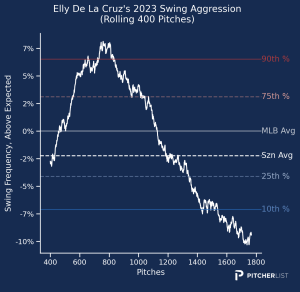
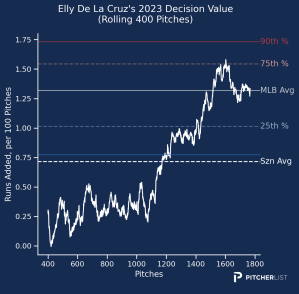
7. Bo Bichette (SS, TOR) – A second straight season of reduced steals (25 in 2021, 13 in 2022, and just five in 2023) puts the overall upside in question, to be sure, and you have to wonder what he could look like if he started pulling the ball more and/or putting the ball in the air more consistently. The ratios are excellent and should remain excellent, but there has to be more than 25 home runs if the stolen base stoppage continues. This ranking is because I do believe that there’s a path towards more, either with more steals or more home runs, and the floor is so high that I couldn’t justify dropping him further.
Tier 3
8. Oneil Cruz (SS, PIT) – Injuries robbed us of a Oneil Cruz breakout in 2023, but all of the pieces are there for 2024 to be the year. While the power hadn’t shown itself in that nine-game sample last season, the high walk rate and low strikeout rate were a continuation of the trends we saw at the end of 2022. Cruz is a player with 30-30 upside, and if he can show that he’s capable of even average decision-making, the 6’7″ shortstop could be a top-20 hitter as soon as this year. As we discussed in one of the panels for PitchCon, there’s a good chance the price on Cruz shoots up in the spring when the statcast data makes its rounds, and folks remember that this guy can hit the ball 120 miles an hour. This is an aggressive ranking, perhaps, but I think more and more will start to see the light when he’s back on the field.
9. Gunnar Henderson (3B/SS, BAL) – It was rough for two full months as Henderson hit just .201/.332/.370 with a 31% strikeout rate through the end of May with many questioning whether he’d be a bust for 2023. The script flipped quickly, though, as he slashed .278/.323/.538 over the remainder of the season with 23 home runs, 72 runs scored, 68 RBI, and eight steals with a dramatically reduced 23.3% strikeout rate. Making that adjustment—which oddly enough came from being intentionally more aggressive—was critical, and hopefully, he can continue to balance his aggression with making contact.
I’m curious about whether they’ll keep Henderson at the top of the order or if they’ll ever let Mullins sneak back into that role, but regardless Henderson should have a prime spot in a lineup that surprised in 2023 and should get even stronger in 2024.
10. Nico Hoerner (2B/SS, CHC) – Those in deeper formats should probably move Hoerner up within this tier as stolen bases have a higher premium in those leagues, but even in shallow leagues, you are welcome to get excited about his 43 stolen bases in 2023. Fifteen is probably the hard ceiling for home runs for the slap-hitting middle infielder, but the excellent contact ability and the ever-present green light should allow Hoerner to come close to matching his 2023 stat line in 2024.
Tier 4
11. Dansby Swanson (SS, CHC) – Swanson hit more ground balls than usual in 2023 and it led to slightly lackluster numbers in home runs and batting average, but he remained a dependable player who can accumulate counting stats due to his durability and place in the lineup. It’s hard to say what the Cubs lineup will look like on opening day due to the number of players they’ve been attached to this offseason, but he should stay somewhere in the top six spots and that’s all Dansby needs to get another 160-170 combined runs and RBI along with 20-25 home runs and close to 10 stolen bases.
12. Xander Bogaerts (SS, SDP) – Bogaerts rebounded nicely from his awkward 2022 with 19 home runs and 19 stolen bases in his first season with the Friars while maintaining strong ratios. I expect Bogaerts to lead off in San Diego following the Soto news, which means he may struggle to clear 60 RBI, but on the bright side, he should score 85 or more runs in front of Tatis and Machado despite the loss of Soto.
13. CJ Abrams (SS, WAS) – For some reason, it took three full months before Washington realized that Abrams could steal bases and should maybe lead off for the Nationals. He stole just nine bags through the end of June, but after being promoted to the leadoff role in early July, he stole 16 bases that month, then 13 in August, and then nine more in September. Abrams has always been excellent at making contact, and in 2023 we finally saw some improvements in his decision-making ability. Abrams’ quick bat and aggression will always keep him from being an elite decision-maker by our metrics, but as long as he continues to make 90th-percentile contact, there’s a path toward 20 home runs and 50 stolen bases. The ratios will stink because he pops out a fair bit and tries to put too many balls in play, but his mix of power and speed will push him up a lot of boards as folks hope that the big spike in steal attempts sticks around.
By the way, this ranking is for his head-to-head categories value, which is highly variable based on your specific need for steals. He’s inside the top-50 hitters in roto leagues as the volatility of steals has less of an impact.
14. Matt McLain (2B/SS, CIN) – McLain won’t repeat his .290 batting average without a lot of batted ball luck (he’s not the type of hitter who can hit almost 25% line drives like he did in 2023), but there’s a good enough power and speed combo to give McLain a shot at 20-25 home runs and 15-20 steals for the Reds along with above-average counting stats. The decision-making and contact ability were progressing in the wrong direction, which raises some alarm bells, but to me that gets offset by the strong debut last season, at least to some degree. It’s also why I’m much lower on him than his current NFBC ADP.
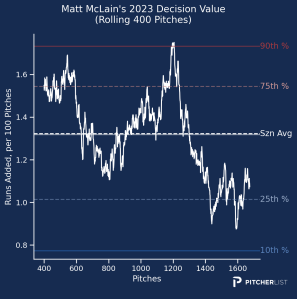
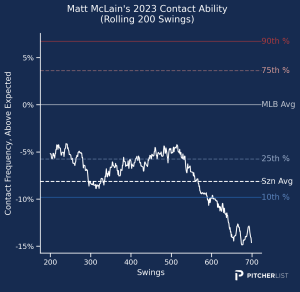
Tier 5
15. Willy Adames (SS, MIL) – Home runs and counting stats shouldn’t be an issue for Adames as 2023 proved that his glove will keep him in the lineup even during the ugliest of slumps. This was the second consecutive season, though, in which Adames was poison to your batting average and OBP, and also his hard hit rate took a noticeable dive to 36.1%. He’d been in the mid-40s as a Brewer from 2021 to 2022, and unless Adames can hit the ball with authority more consistently, he could get buried in the lineup again. That would cap his counting stat ceiling significantly and make it even harder to stomach the .220 to .230 batting average we have to expect from Adames in 2024. All that being said, guys in this range who can hit 30 home runs and have 170 combined runs and RBI are not easy to come by.
16 Ha-Seong Kim (2B/3B/SS, SDP) – Another player who exceeded all reasonable expectations in 2023, Kim wound up at the top of the order and slapped his way into 17 home runs, 38 steals, and 84 runs scored. The stolen base upside is pulling him up these rankings, and his strong plate discipline should help Kim recreate something close to his .351 OBP from 2023. I’m not sure Kim can flirt with 40 steals again, but even if he only gets 30, he should be well worth this price.
The trade of Soto may have a weird effect on Kim as it will open up the top of the lineup. The Padres could move Kim to the number one or two spot as his contact-oriented approach is ideal for those roles, but San Diego is so right-handed heavy at this moment that they could also choose to use Cronenworth in that role and move Kim to fifth or sixth. Kim’s skillset is best for fantasy when he’s batting first or second, though hitting lower isn’t a bad thing for his RBI totals and he should get plenty of opportunities to run in either situation.
17. Thairo Estrada (2B/SS, SFG) – Despite missing over 40 games in 2023, Estrada managed to hit just as many home runs and steal a few more bases than he did in 2022 while also hitting for a better average. Estrada should again find himself at or near the top of the Giants lineup, but as it currently stands, the Giants offense will not create many run-scoring opportunities. 15 home runs and 25 steals could be there, but the counting stat totals aren’t going to be pretty unless the Giants make significant changes to the lineup and Estrada’s health risk exacerbates the counting stat issue even more.
18. Anthony Volpe (SS, NYY) – The fact Volpe played 159 games and knocked 21 home runs with 24 steals made his 2023 a success even if it fell short of the lofty expectations of prospect chasers. Expect Volpe to improve on his counting stats and ratios in his second full season with an improved supporting cast, and if he can dig his way out of the bottom of the order, he could become a top-50 hitter before you know it. There is, of course, the risk that the strikeouts don’t come down and he continues to post subpar ratios that force the Yankees to bury him in the lineup, but that would be lame and not fun so I’m trying not to think about it.
19. Ezequiel Tovar (SS, COL) – It was great to see Tovar get a chance to play the full season as the primary shortstop for the Rockies, even if it came with lackluster results. While I desperately wish I had a rolling chart to show you that indicates growth or improvement, I wasn’t able to find anything of the sort. Growth doesn’t always happen on the field, though, and the one-time top-50 prospect has a good enough hit tool to hit .280 in the big leagues while throwing in 17-19 home runs and close to 15 steals along with whatever counting stats are available in Colorado, but until we start seeing actual signs on the field, it’s hard to call him anything more than an upside play.
Tier 6
20. Jeremy Peña (SS, HOU) – Peña’s 2023 was an improvement in some areas, such as plate discipline and OBP, but it came with a huge downturn in power thanks to a much higher groundball rate that he was not useful for fantasy. If Peña can get back to 20 home runs to go with his improvements at the plate and his 13-15 stolen bases, he could be a very steady contributor in the middle infield. If he once again barely manages double-digit home runs, he’s not worth rostering in 12-teamers. The one thing Peña has going for him, though, is that his glove will keep him in the lineup every day, meaning he’ll have every opportunity to find a way back to his 2022 self.
21. Carlos Correa (SS, MIN) – Believe it or not, this was the fourth consecutive season that Correa appeared in over 80% of his team’s games, though unlike the two previous campaigns, it was not considered a success. Correa fell flat in almost every category, and one explanation could be the plantar fasciitis he battled throughout the season. Assuming Correa finds a way to manage the condition over the offseason (it doesn’t require surgery), he could certainly recapture his 2021 or 2022 form and put up 22-25 home runs with solid counting stats and a .280 or better batting average. The floor is particularly low for the former first-overall pick, but there’s enough ceiling here that someone should probably draft him in your league.
22. Jordan Lawlar (SS, ARI) – Lawlar third on this list over Holliday? Matt Heckman has been one of the biggest advocates for Lawlar and 14 major league games will not change his mind. Lawlar’s home run per fly ball numbers have been impressive throughout his professional career and there is 40+ stolen base potential here. He should usurp Geraldo Perdomo as the everyday shortstop early on in 2024 (possibly as early as Opening Day) and be a reliable fantasy asset for managers this season.
Here is what Matt concluded about Lawlar in the composite article:
“The speed and power combination possessed by Lawlar is exciting. The upside in his profile is huge and there is no reason to overreact to a small major league sample size. He will have a fantasy impact in 2024 and should be on your radars during draft season.”
23. Jackson Holliday (SS, BAL) – Holliday’s quick ascent through the minor leagues has been impressive. With the potential to be a generational talent, Holliday is on the cusp of making his major league debut. With a strong spring, he could find himself as the team’s Opening Day shortstop. There is also a chance the team opts to give Holliday some more time to develop in Triple-A considering he does not turn 21 until next December. There is five-category potential in Holiday’s bat although we have yet to see his raw power fully translate to game power.
Here is what Martin concluded in our composite write-up:
“The Orioles are so loaded with young talent and Holliday is the cream of the crop. The team has already stated Holliday will compete in spring training to make the Opening Day roster. Personally, I think it is a foregone conclusion that Holliday will not only make the Opening Day roster, but he’s a heavy favorite for AL Rookie of the Year.”
24. Vaughn Grissom (SS, BOS) – If you’re looking for a high-floor, low-ceiling middle infielder who should get to 12-15 home runs and stolen bases with a decent batting average and low counting stats, Grissom is your guy! You don’t often see a player with just 64 games major league games with such tight projections, but Grissom’s high-contact, low-to-medium power approach near the bottom of a not-so-great lineup provides an uncomplicated projection based on players we’ve seen before who are like him. For Grissom to break into the top 100 hitters, we’d need to see him keep the ground ball rate at or below 45% (something he did in the minors) and that line drive rate would need to be above 20% (another thing he did in the minors). That combination was the secret to his success in Triple-A, where he hit 36 doubles with a .330 batting average. You can bump Grissom up a tier or so in most points leagues due to his contact-oriented approach.
25. Tommy Edman (2B/SS/OF, STL) – I was not at all in on Tommy Edman in 2023 due to his move to the bottom of the order and his historical performance in that spot, and while Edman has a clear starting role and is coming off a third straight season with at least 27 home runs, I’m still not overly excited about the other assets Edman brings to the table. Edman finished as the 130th best hitter last season according to the FanGraphs auction calculator with stolen bases being the only category where he didn’t provide negative value. I don’t see much reason to suspect anything to improve much in 2023, which makes Edman better suited to deeper roto leagues than anything else for the speed.
26. J.P. Crawford (SS, SEA) – Crawford’s 19 home runs were more than he had in the prior three seasons combined (covering 358 games) and the most compelling narrative relates to changes he made over the offseason with Driveline. Crawford did manage to get the ball in the air more and did pull the ball more in 2023 than in any other season as a Mariner, and the elevated walk rate helped him score 94 runs. Crawford should be the primary leadoff man again in 2024, and even if the power takes a bit of a step back, the floor is extremely high thanks to his ability to make contact and take walks. This isn’t a big upside play, but he’s easily the safest bet in this entire tier.
Tier 7
27. Zach Neto (SS, LAA) – Neto ran into serious trouble during his debut in 2023 and saw his contact ability decline sharply throughout his season. Assuming he can figure out how to make more contact, Neto could be the leadoff guy for the Angels and hit 20 home runs and 10 stolen bases with a .250-.260 average, but fixing contact issues is not a simple endeavor.
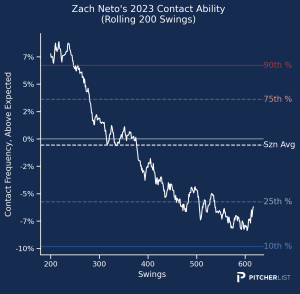
28. Luis Rengifo (2B/3B/SS/OF, LAA) – The super-utilityman Rengifo started walking a lot more than he had in 2021 and 2022, but other than that, it’s hard to imagine him being more than the 16-18 home run hitter with decent ratios that he’s been for the last two seasons. You’ll probably pick up Rengifo at various points in the season when dealing with injuries or when he’s heating up, but you don’t need to draft him in a format that includes a waiver wire.
29. Orlando Arcia (SS, ATL) – Arcia finished as a top-20 shortstop in 2023 thanks to, well, playing in 139 games for Atlanta. He was actually on track to finish inside the top 15 or so until a putrid September knocked him down a few pegs (just a 54 wRC+ that month). Arcia didn’t do anything out of the ordinary or outside of his ability (though he had some luck in his batting average that I expect to fade away) and his glove is good enough that he should be able to stay in the lineup unless his bat falls apart.
30. Amed Rosario (2B/SS, FA) – No matter where Rosario ends up, a .270 batting average and 10-12 home runs with 15 steals will likely follow. If that lands at the bottom of a team’s batting order, it’s replacement-level stuff that you can leave on the wire most of the time in a 12-teamer. If it finds its way near the top of the order, that’s a different conversation.
Photo by Scott Winters/Icon Sportswire | Adapted by Justin Paradis (@JustParaDesigns on Twitter/X)

